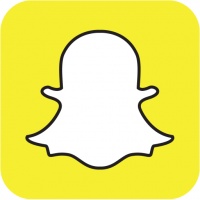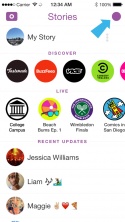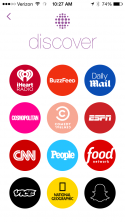Snapchat
|
Snapchat is a social media app that allows users to send photos and videos to each other. Different effects, captions and drawings can be added to these 'Snaps,' Users choose how long they want their snap to last for. It can last for up to 10 seconds and then disappears. It wasn't until 2013 that users were able to replay one snap a day. Snapchat has become the 3rd most popular social networking platform among millennials. It is currently ranked number 4 on the 'Top Charts' for app downloads in the Apple iTunes Store.
Contents
History
Reggie Brown and Evan Spiegel are the co-creators of Snapchat. They met freshman year at Stanford University when they joined the same fraternity. In Kappa Sig, Spiegel and Brown met fellow co-founder and future programmer of the app, Bobby Murphy. Brown and Spiegel had a knack for entrepreneurship and launched an app called Picaboo in July of 2011. Brown sparked the idea when he said, "I wish these photos I am sending this girl would disappear." Picaboo was later renamed to Snapchat. They gained users little by little, but where the app really became popular was among High Schoolers.
In April 2012, Lightspeed Venture Partners invested $485,000 into Snapchat. This was the first big investment Snapchat received. By Winter of 2012 the app was released to Android phones. Snapchat also introduced the video sending feature. By February, over 60 million snaps were being sent each day.
By May of 2013, 150 million snaps were being sent each day. With Snapchat's growing popularity and success, Mark Zuckerberg offered to buy Snapchat for $3 billion in November of 2013, but Snapchat refused.
Despite the app's growing success, there was an ongoing lawsuit between the original founders about who truly came up with the idea for the app. After years of battling it out in court, it wasn't until 2014 when the lawsuit was finally settled between the founders when they paid Reggie Brown an undisclosed amount.
By May of 2015, Snapchat was valued at $16 billion.
Features
When snapchat was first launched users were only able to send pictures to each other. But, with each update Snapchat has introduced more and more complex features.
Snapchat Videos
In December of 2012 Snapchat introduced the video feature. Users can take and send videos via Snapchat to their friends. Snap videos cannot be re-watched and disappear after they are watched. A snap video can last up to 30 seconds.
Snapchat Story
In October of 2013 Snapchat introduced the story feature. Previously the only people that could see your snaps were other users that you individually sent snaps to. Story allows users to post a snap of a photo or video that everyone on their list of Snapchat friends can see. It is automatically deleted after 24 hours, but unlike individual snaps stories it can be watched many times. There is also a way to see who watched your snap story or took a screenshot.
In June of 2014 the 'Our Story' feature was released. Users could now post their snaps to a single-event based story that all Snapchat users could see. The 'Our Story' featured different cities, sporting events, fashion shows, holidays and more. Snapchat was no longer just a way to communicate with friends but a way to stay updated with different cultural and world events.
Instant Messaging and Video Calling
In May of 2015, Snapchat introduced an instant messaging and video calling feature. Users were only able to use this when both participants were on the app.
Discover
In January of 2015 Snapchat introduced the Discover feature. It allows Snapchat users to see content from different brands or networks like MTV, CNN, People and National Geographic that is updated daily. They post short content videos with the option to read the full story.
Filters and Effects
In December of 2013, Snapchat introduced timestamps, temperature, and speed overlays.
In September of 2015 Snapchat introduced different lenses for selfies. Users are able to distort their selfies and add different animations. Snapchat changes the different lens options frequently but users are able to buy them to use permanently for $0.99.
Geofilters were eventually introduced. They are visual overlays that can only be used at certain locations. For example major cities and famous locations have geofilters for users to use. Anyone can make and submit an image for a geofilter to Snapchat for approval. Companies can also sponsor geofilters to promote their brand or product. This has become a source of major revenue for Snapchat.
Ethical Concerns
Do The Pictures Truly Disappear?
What separates Snapchat from other photo and video messaging apps is that the content sent to Snapchat friends vanishes. This 'disappearing' feature sends mixed messages to users. Many users think this means they can send explicit content without ever having to worry about it being on the internet forever. In fact, this goes against every social guideline of the internet. The golden rule of the internet is that whatever is put on the internet is there is there forever and virtually anyone can figure out a way to see it. Even if you press 'delete' it does not mean that content is permanently gone. It is very difficult, if not impossible, to permanently delete files from cyberspace. Therefore, internet users are taught from an early age about the dangers of putting personal and explicit content on the internet. Snapchat has even admitted that the photos sent through the app do not completely vanish. In fact in 2011, someone figured out a way to get these 'deleted snaps' back. Founder Evan Spiegel responded to this hack saying, "The people who most enjoy using Snapchat are those who embrace the spirit and intent of the service. There will always be ways to reverse engineer technology products — but that spoils the fun!" While this might be true, the misperception that snaps are deleted has caused many problems.
Privacy
Screenshots
The only way to save a snap is to take a screenshot of it but, the original sender of that snap is notified. This encourages users to not take screenshots Snapchat figured that the screenshot notification would limit the 'screenshotting' taking place
Sexting
References
http://www.businessinsider.com/snapchat-huge-among-millennials-2015-5
http://money.cnn.com/2012/12/28/technology/security/snapchat-security-flaw/
http://mwpartners.com/snapchat-is-now-the-third-most-popular-social-network-among-millennials/
https://www.snapchat.com/geofilters
http://techcrunch.com/gallery/a-brief-history-of-snapchat/
http://techcrunch.com/2015/01/27/snapchat-launches-discover/



